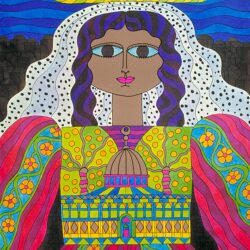From the MoMu Collection

This miniature version of a silhouette by Dries Van Noten is a fashion doll wearing the final look from the S/S 2016 show by the Belgian designer.

This custom-produced Dries Van Noten silhouette (on a 1:3 scale) was produced by the Antwerp pattern studio, Trois Quarts. The catwalk look is comprised of a jacket in purple lurex, embroidered with bronze-coloured sequins in the shape of wings. Beneath the jacket is a bronze-coloured lurex top, under a short, white bustier with circular-shaped cups. The wide, salmon-pink skirt bears various layers of pleated tulle in beige and white. The top layer is set with diamond-shaped pieces of pleated white tulle. Around the waist is a cognac-brown leather belt.
Anatomy of the Silhouette
The greatest challenge for the Trois Quarts studio was to believably recreate all the details to scale, without detracting from the overall effect of the original silhouette. They therefore thoroughly studied how the silhouette had been built. In order to find the right materials, they received help from the Dries Van Noten studio. For example, an exact replica of the jacket in the same fabric would be too full and too heavy. For this reason, the sequins were sewn on by hand in the form of a sketch. But it was primarily the skirt that required advance research. Trois Quarts decided to gather the top layer of tulle first, and then draw on a raster. The pieces were subsequently stitched onto a second layer of tulle, in a big zig-zag shape. After that, they carefully cut in the loose shapes.
Fashion Show for Dolls
With this project, MoMu looked back to the origins of the doll, or mannequin. Originally, dolls were not things to be played with, but served to model fashion silhouettes. In the 14th century, dolls formed a kind of mini-parade on the move. They were used to present regional styles – mostly courtly apparel – and in this way helped disseminate the newest fashion trends. In times of crisis, they served to boost national economies and display national pride. After the Second World War, for example, the Syndicat de la Couture Française organized the Théâtre de la Mode: an exhibition of 237 miniature dolls, all dressed by the Parisian fashion houses. Along these same lines, the fashion doll on view at Sapphire House Antwerp brings the MoMu Collection beyond the walls of the museum.









